Table of Contents
The role of dopamine in AUD is complex and has been reviewed in detail elsewhere [10,11,12,13]. Briefly, acute alcohol increases dopamine release across the striatum [14] primarily due to increased firing of midbrain dopaminergic neurons, an effect that may underlie the initial reinforcing properties of alcohol. In individuals that drink alcohol frequently, however, tolerance develops, and more alcohol is consumed. Concomitantly, adaptations in glutamatergic, https://ecosoberhouse.com/ GABAergic, and dopamine transmission occur [15] and greater or continued amounts of alcohol can result in allostatic changes to preserve normal brain function. This allostasis is characterized by aberrant glutamate, GABA, and opioid signaling, as well as, a dysfunction in nigrostriatal and mesolimbic dopamine transmission [16, 17]. The mechanisms underlying this dysregulation of dopamine transmission are not well understood, particularly in a primate brain.
- For example, different subpopulations of neurons in the striatum carry different dopamine receptors on their surfaces (Le Moine et al. 1990, 1991; Gerfen 1992).
- Investigators have postulated that tolerance is regulated by connections between neurons that produce multiple neurotransmitters or neuromodulators (Kalant 1993).
- Altered emotional processing has been found both during alcohol intoxication and dependence and appears to worsen as consumption increases.
- Dopamine that has been released from a nerve terminal into the synaptic cleft can travel out of the synapse into the fluid surrounding the neurons and activate these extrasynaptic receptors.
Physical Signs and Other Symptoms of Alcoholism & Alcohol Abuse
Repeated alcohol exposure in mice activates another PTK, Src, which in turn stimulates Nf-κB/Tnfα signaling in microglia, resulting in microglia engulfment of mPFC synapses, as well as synaptic pruning and increased anxiety-like behaviors [57]. Another serine/threonine kinase that participates in neuroadaptations underlying AUD is GSK3β [58]. Specifically, Gsk3β in the mPFC participates in mechanisms underlying motivation to consume alcohol and alcohol withdrawal-induced anxiety [58].
Place obstacles between you and your addictive behaviors
Our conclusions would have been strengthened by including plasma measurements of amino acids to confirm the effectiveness of the P/T depletion procedure. In addition, this study only included males due to sex differences in the dopamine system [118, 119]. Finally, preclinical studies demonstrate phasic dopamine release in response to conditioned reinforcers [23, 36], and P/T depletion suppresses spontaneous dopamine transients in the NAc of rats at rest [57]. However, in this study, the behavioral tasks were performed after the resting-state scan; future work pairing event-related fMRI AB tasks with the P/T depletion procedure may provide additional insight into the dopamine response to alcohol or non-drug reward cues.
Level 3: Alcohol’s effects on transcriptional activity
Most individuals cease alcohol use after the administration of disulfiram due to the strong expectancy of negative consequences. Alcohol reduces glutamate levels in the nucleus accumbens and suppresses glutamate-mediated signal transmission in the central nucleus of the amygdala. The positive reinforcing action of alcohol comes from the activation of the dopaminergic reward pathway in the limbic system. Dopamine is a neuromodulating compound that is released in the ventral tegmental area (VTA) and projects to the nucleus accumbens (NA) where it is acutely alcohol and dopamine involved in motivation and reinforcement behaviours. Young males who have experienced a traumatic event can develop lowlevels of MAO‑A expression (an enzyme that breaks down serotonin), and this decrease in MAO‑A levels correlates with an increase in antisocial behaviour, which is a risk factor for alcohol dependence. Although numerous studies have attempted to clarify dopamine’s role in alcohol reinforcement by manipulating dopaminergic signal transmission, these investigations do not allow any firm conclusions (for a review, see Di Chiara 1995).
Capitalizing on your motivation or eliminating apathy and inaction means keen awareness of the powerful role of rewards and your unique dopamine production. We all have our own personalities, preferences, and quirks, and they should all be reflected in our styles. Yoshimoto K et al., Alcohol stimulates the release of dopamine and serotonin in the nucleus accumbens. Patients with schizophrenia are also highly likely to suffer from alcohol abuse due to their tendency to devalue negative consequences and overvalue rewards [21]. Genetic susceptibility linked to thiamine transporter genes may be involved in the development of WKS in vulnerable patients.
Alcohol vs Weed: How Similar Are Their Effects on the Body? – DISCOVER Magazine
Alcohol vs Weed: How Similar Are Their Effects on the Body?.
Posted: Wed, 07 Dec 2022 08:00:00 GMT [source]
The dopamine system and brain reward circuitry
- In the largest of the studies [159], 100 recently abstinent alcohol‐dependent patients were randomized to 300 mg of tiapride or placebo for a 3‐month treatment period.
- Alcohol use disorder is diagnosed on the basis of criteria defined in the fifth edition of the Diagnostic and Statistical Manual of Mental Disorders (DSM-5).
- Another mechanism by which thiamine deficiency leads to cytotoxicity is by affecting carbohydrate metabolism leading to the reduction of the enzyme α-Ketoglutarate Dehydrogenase, leading to mitochondrial damage, which in turn induces necrosis [61].
- Furthermore, GsDREADD-dependent activation of the serine/threonine kinase protein kinase A (Pka) in the DMS of mice activates Fyn specifically in D1R MSNs to enhance alcohol consumption, suggesting that Pka is upstream of Fyn [54].
- Through the translation of these transcripts and others, mTORC1 contributes to mechanisms underlying alcohol seeking and drinking as well as reconsolidation of alcohol reward memories and habit [44–46].
Alcohol and Neurotransmitter Interactions
rs.type = ‘text/javascript’;
- Therefore, mechanisms regulating alcohol reinforcement might be different in selectively breed high alcohol‐consuming rats compared to outbreed rats, and this should be investigated in more detail.
- A striking example is the discovery that certain neurotransmitters, such as serotonin [109] and dopamine [110], can covalently bind to histones and act as epigenetic marks to regulate gene expression.
- The study concludes by stating that it was the 1st time that such an association was found with the stated polymorphism and AD.
- Long-term alcohol intake also induces changes in many neurotransmitter systems that ultimately lead to the development of craving and alcohol-seeking behavior.
 Loading location...
Loading location...


